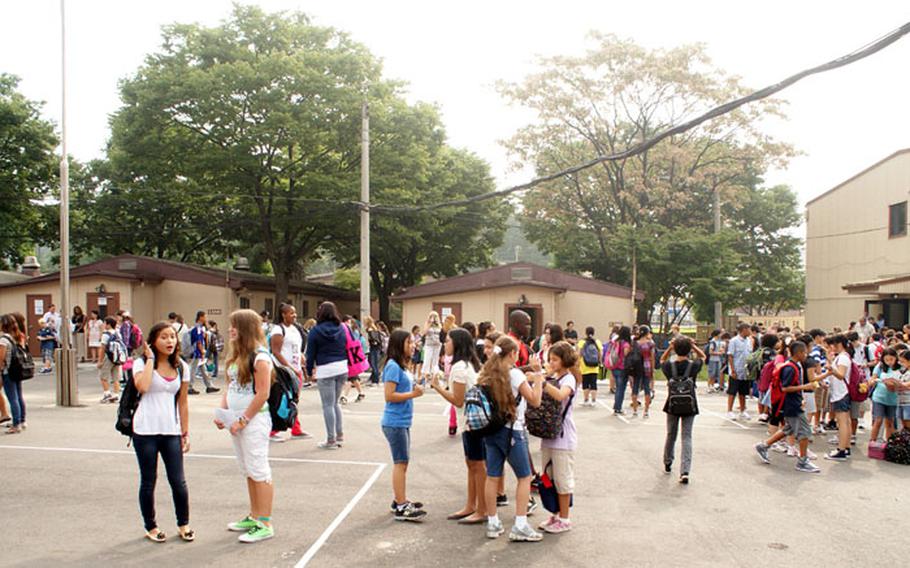
Students take a break during the first day of school at Seoul American Middle School on Aug. 29, 2011. (Alfredo Jimenez Jr./Stars and Stripes)
YOKOTA AIR BASE, Japan - Department of Defense Dependents Schools will look for savings at the head office rather than in the schoolhouse if lawmakers can't reach a compromise to avert $100 million in cuts to the federal budget scheduled to take effect as early as next month, officials say.
School districts near military facilities in the U.S., fearing reduced government funding, already have begun to lay off staff, cut athletic and academic programs and cancel equipment orders, field trips and maintenance projects, Stars and Stripes reported last week.
However, Adrian Talley, Department of Defense Education Activity (DODEA) principal deputy director for education, said Monday that leaders aren't yet talking about cutbacks within DODDS.
"The discussion about sequestration is not one we are really having," he said during a tour of schools in Japan, adding that military schools will ensure programs for children stay strong, even if cuts are implemented.
"It's important for parents to know that the education of our children is foremost and we would not put the cuts on them - the kids," he said.
If the defense budget is slashed, military school officials will likely look at head office efficiencies first, he said.
"It (sequestration) may or may not occur," he said. "We have to see."
Recent cost-saving changes to athletic and scholastic programs in the Pacific are not related to sequestration, Talley said.
The changes will see Far East high school sports tournaments shortened by up to two days and athletes per team trimmed by at least one, officials said last Friday.
"We are always looking for efficiencies, as any organization would," Talley said, adding that the changes will allow the programs to continue despite increasing costs.
For example, DODDS-Pacific is saving money by sending students to the Yale Model United Nations in Seoul this year instead of the Harvard Model Congress Asia in Singapore. A mathematics event that was held on Okinawa with U.S. university professors in past years will now be held at Tsukuba University on mainland Japan with Japanese professors, he said.
"In Singapore, the cost in per diem was a lot for us [and] at Tskuba the students will stay in dorms rather than a hotel," Talley said.
Martha Brown, senior civilian leader at DODEA-Pacific, said, despite the cuts, students in the Pacific have more opportunities now than five years ago.
"We want to be able to maintain that as costs go up all around us," she said.
Lois Rapp, Japan District superintendent, said the budget for athletics and other activities has not been reduced.
"Our budget has flat-lined, but the costs have increased for many of these events," she said.
DODEA-Pacific spokesman Charles Hoff said increases in airfare and accommodation costs and currency fluctuations have put pressure on the budget for events that more than 3,000 students participate in each year.
DODDS has opted to change venues and reduce the number of participants and length of events rather than cutting them completely even though many - such as the Far East baseball, softball and track-and-field competitions - didn't exist five years ago, he said.
Talley said construction will go ahead at Yokota Air Base, where a new high school will be built in 2014; Misawa Air Base, where Edgren High School will be renovated; and at Sasebo Naval Base, where the elementary and high schools will be renovated.
Officials continue to make improvements at Zama High School, which received a poor rating by inspectors last year and will be inspected again in April, he said.
"The focus and the commitment are all going in the right direction, and that is focused on students and creating the right environment," he said of the school.
Rapp said a key part of the school's improvement plan involves addressing and resolving what inspectors characterized as an "obstructive and negative climate perpetuated by an intimidating, manipulative minority of staff."
Half of the high school staff is new this year, and there's an additional assistant principal, she said.
The staff has introduced a new school newspaper and a choral group, Brown added.
A high number of students from Camp Zama are accepted to service academies such as West Point, and academic achievement at the high school has never been an issue, she said.
The mean SAT score at the school, which had a 100 percent graduation rate last year, was 1470, just under the national average of 1498.
"The issues were more adult issues that were not focused on students," Brown said.